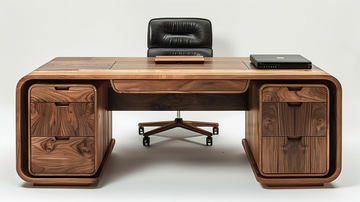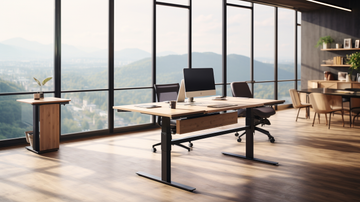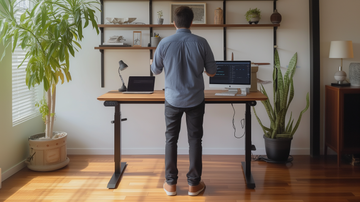Introduction
Solid wood desks are growing in popularity compared to desks made from materials like particle board or medium density fiberboard (MDF). Solid wood offers unique benefits in terms of quality, durability, and aesthetics.
Unlike particle board or MDF, solid wood is made from continuous wood fiber and not wood scraps glued together. This makes solid wood much stronger and more durable over the long term. Solid wood desks can potentially last for generations with proper care and maintenance. Particle board and MDF are more susceptible to scratches, dents, and water damage (source).
Solid wood also has natural variations in grain patterns and color, giving each desk a unique look. The wood can be sanded and stained to achieve different finishes. Particle board and MDF have a uniform, manufactured appearance. For those wanting a high quality, customizable desk, solid wood is the superior choice.
Additionally, solid wood is more eco-friendly and sustainable than particle board. It does not emit harmful formaldehyde like some composite wood products. When sourced responsibly, solid wood comes from trees grown and harvested specifically for lumber production. Overall, for its strength, durability, aesthetics, and environmental benefits, solid wood makes an excellent material for quality desks meant to last.
Different Types of Solid Wood
When selecting a solid wood desk, some of the most popular and durable wood species include:
- Oak - Red oak is a very strong hardwood that resists scratches and dents. It has a bold grain pattern. White oak has a more subdued grain but is also quite strong. Oak has a range of color from light tan to reddish brown. (Source)
- Maple - Hard maple is a durable and dense hardwood that comes in a light tan color. It has a fine, straight grain pattern. Maple is scratch and dent resistant. (Source)
- Cherry - Cherry wood has a rich reddish-brown color and ages beautifully over time, darkening into a deeper red-brown. It has an elegant, fine grain pattern. Cherry resists warping but is softer than oak or maple. (Source)
Other wood species like walnut, birch, and mahogany are also sometimes used for desks. Ultimately the type of wood comes down to aesthetic preferences and budget.
Wood Grain Patterns
The grain pattern of wood refers to the arrangement and direction of the wood fibers and growth rings. This is one of the most important factors that determines the look and feel of a solid wood desk. According to Duffield Timber (https://duffieldtimber.com/the-workbench/categories/timber-trends/wood-grain-patterns-types-textures-terminology), there are several common types of grain patterns:
- Straight grain - The fibers run parallel to the length of the board, creating consistent straight lines.
- Wavy grain - The fibers undulate across the board, creating a fluid, wave-like pattern.
- Spiral grain - The fibers twist in a spiral pattern across the growth rings.
- Interlocked grain - The fibers crisscross each other, creating a complex geometric pattern.
- Curly grain - The fibers are distorted, producing elaborate curved patterns.
The wood grain greatly impacts the look of the finished desk. Straight grain tends to be the strongest and most stable. Wavy, spiral and interlocked grains create more visual interest. Curly grains are prized for their decorative appeal. According to Schenck & Company (https://www.schenckandcompany.com/wood/wood-grain-patterns/), figuring out the type of grain can help determine the best way to cut the wood to highlight its natural beauty.
Stain vs Natural Wood
When choosing a solid wood desk, one decision is whether to go with a natural unfinished wood look or use stains. Both have their pros and cons.
The advantage of staining is that it allows you to change the color of the wood to match your preferred decor. Stains come in a wide variety of hues from light natural tones to dark walnut colors. Staining also helps protect and seal the wood. The downside is that staining can mask the natural beauty of the wood grain.
Opting for an unfinished natural wood look highlights the inherent beauty of the wood grain patterns. Each desk will be unique based on the natural variations in the wood. The cons are that unfinished wood is more prone to scratches and stains from daily use. The wood color will also naturally darken and change over time as it oxidizes.[1]
Ultimately it comes down to personal preference. Those wanting to customize the color or add protection may opt to stain their solid wood desk. Those who want to showcase the wood's natural grain and color may leave it unfinished.
Desk Style and Design
There are many different style options to consider when choosing a solid wood desk. The style you select will impact the overall look and feel of your workspace.
Some popular desk styles include:
- Modern - Clean lines, minimal ornamentation. Often made of lighter woods like maple or birch. Glass or metal accents are common. See examples at https://www.cabinfield.com/blog/how-to-choose-your-perfect-solid-wood-desk/
- Rustic - Natural, rough-hewn look. Commonly uses woods like pine, oak, or hickory. May incorporate imperfections in the wood as part of the charm. Check out rustic styles at https://vermontwoodsstudios.com/collections/solid-wood-desks
- Industrial - Inspired by factory or workshop furniture. Steel and iron accents. Woods tend to be darker like walnut or espresso. See industrial desk options at https://www.countrysideamishfurniture.com/products/executive-desks
- Traditional - Classic stylings like Queen Anne legs or distressed paint techniques. Mahogany, cherry, and walnut are commonly used. Conveys a sense of heritage and craftsmanship.
The style you choose should align with your overall decor and design aesthetic. Think about the look you want to cultivate in your workspace.
Desk Size Considerations
When choosing a solid wood desk, it's important to consider the size of the space you plan to put it in as well as your needs for workspace and storage. Here are some tips on selecting the right size desk:
Measure the area where you plan to place the desk and make sure to leave enough room for entering and exiting the space. Allow for about 2-3 feet clearance on all sides. Also check for any doors or windows that may impact desk placement.
Consider what you'll use the desk for - just a computer monitor and laptop or spreading out books and papers? If you need a lot of workspace, choose a larger size like 60-72 inches wide. For just a computer, 36-47 inches is likely sufficient.
The standard desk depth is about 24-30 inches deep. Go for 30 inches if you'll have monitors, laptops, keyboards, and other accessories to fit.
If you need storage, look for desk sizes that accommodate optional drawers and cabinets. Some common options are 2-3 drawers on one or both sides.
Larger solid wood desks can accommodate multiple users if needed. For a shared home office space, look for sizes in the 60-72 inch range.
For small spaces like apartments, compact desk sizes around 40 inches wide could be a better fit.
Custom-ordering allows fully customizing the width and depth. Ready-made desks come in set sizes but are quicker to obtain.
Take measurements of your space and assess your needs to narrow down the right sized solid wood desk before purchasing.
Desktop Thickness
The thickness of a solid wood desktop is an important factor to consider for durability and stability. Standard thicknesses for solid wood desks range from 3/4" (19mm) to 1 1/2" (38mm).
Thinner desktops around 3/4" thickness may be prone to warping or bowing over time, especially for larger desks. A minimum thickness of 1" (25mm) is recommended for long-term performance. According to one Reddit user, popular brands like Lander and Jarvis use 1.25" thickness for their hardwood desktops [1].
For extra strength and rigidity, opt for a thickness between 1 1/4" to 1 1/2". This provides ample support and reduces the chance of sagging under heavy loads. SolidWoodTops.co.uk notes that their premium solid wood desks range from 18mm to 40mm (0.7" to 1.6") in thickness [2]. Ultimately, thicker is better for optimal durability over many years of use.
Drawers or No Drawers
Desk drawers can provide handy storage and organization for office supplies, files, and other items you want to keep within reach. The benefits of desk drawers include:
- Keeping items organized and tidy so your desk surface stays clear.
- Providing extra storage space for papers, pens, notepads, etc.
- Allowing you to neatly tuck away items when not in use.
- Offering a place to store sensitive documents securely.
However, desk drawers may not be necessary if:
- You prefer a clean, minimalist look without any visible storage.
- You already have enough storage solutions in the room.
- You want to maximize the leg room under the desk.
- You don't anticipate needing extra enclosed storage space.
It's a personal preference whether the convenience of drawers outweighs the sleeker aesthetic of a drawer-less desk. Consider your storage needs and style preferences when deciding.
Custom Order vs Ready Made
When choosing a solid wood desk, one of the main decisions is whether to custom order a desk or buy a pre-made one. There are pros and cons to both options.
Custom ordering allows you to get a desk made exactly to your specifications. You can choose the wood type, finish, size, features like drawers and shelves, and other customizations. The end result will be a one-of-a-kind desk tailored to your needs. Custom ordering from a local woodworker also supports small businesses. However, custom desks are more expensive and can take weeks or months to be built and delivered.
Buying a pre-made or ready-made desk is often cheaper and faster. Ready-made solid wood desks can be purchased online or in stores for quick delivery or pickup. The downside is having less choice in terms of size, features, and customization. There may be some flexibility to choose different finishes or options, but the overall style and design is fixed.
According to Countryside Amish Furniture, custom ordering a solid wood desk allows you to "create a one-of-a-kind piece designed specifically for your space and needs," while ready-made desks provide "an outstanding variety" to choose from immediately.
When deciding between custom vs ready-made, consider your budget, time frame, and how customized you want the desk to be. Custom ordering results in a more tailored desk, while ready-made provides more affordability and convenience.
Conclusion
When choosing a solid wood desk, there are several key factors to consider. First, think about the type of wood you want and its unique grain patterns. Popular choices like oak, maple, and walnut each have their own distinct look. Next, decide if you want the natural wood color to show through or if you'd prefer a stained finish. The desk's style and size are also important - do you need drawers for storage? How much surface area will you need? Custom-built desks allow you to tailor the dimensions and features precisely to your needs. Ready-made solid wood desks provide an affordable alternative if you want something right away. Just be sure to inspect the materials and construction quality before purchasing. With so many options for wood species, sizes, designs and finishes, you're sure to find the perfect solid wood desk to suit your home office, workspace or study area.








